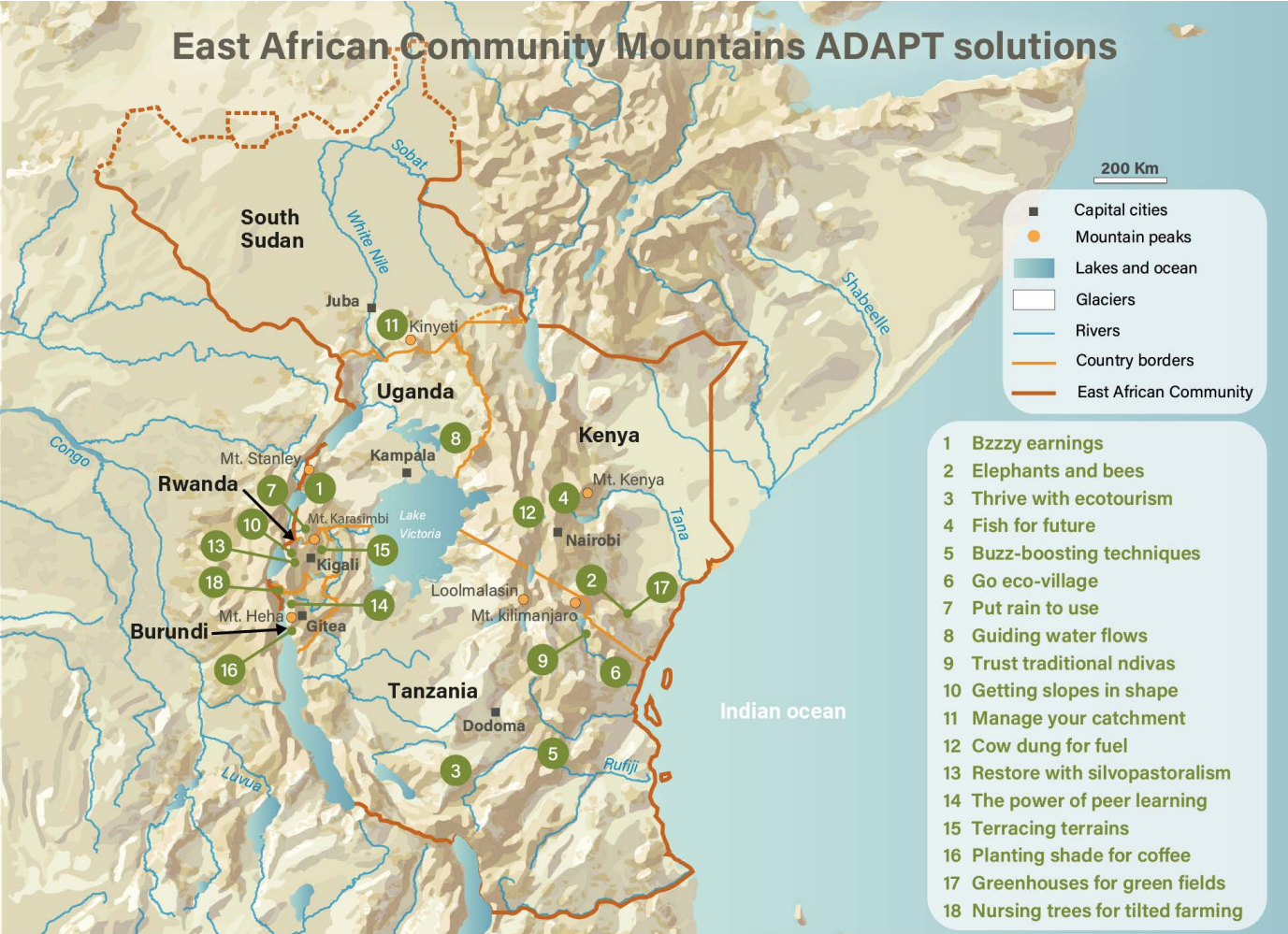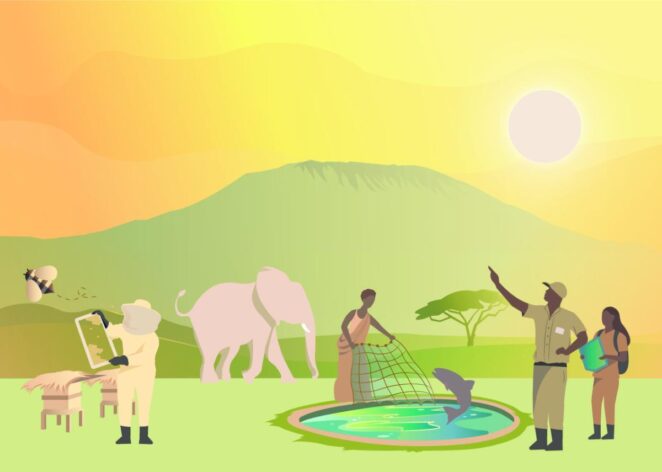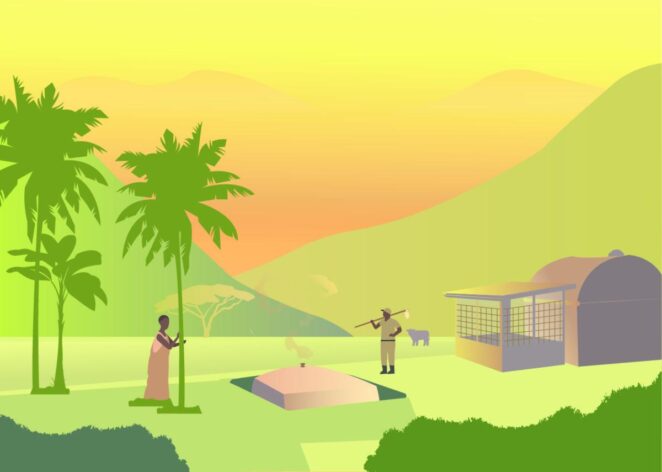Mountains ADAPT: Solutions from East Africa

This publication is an output of the global programme Adaptation at Altitude: Taking Action in the Mountains, funded by the Swiss Agency for Development and Cooperation (SDC).
The solutions included in this publication can also be found on the Adaptation at Altitude Solutions Portal.
Introduction
The Mountains ADAPT: Solutions from East Africa booklet showcases adaptation solutions proven to be successful in response to specific issues caused or accelerated by climate change that negatively affect mountain communities’ livelihoods and ecosystems. These solutions were selected for their inclusive approaches, their potential to be transferred and upscaled, as well as their extended benefits for downstream communities across the region.
The booklet aims to highlight a variety of possible approaches in addressing climate change related vulnerabilities. It focuses on actions and measures that already have been or are being implemented to allow for evaluation of their impacts. Enabling factors are also assessed to show the potential for replication in different sociocultural, ecological, political, or economic contexts, sectors, and geographies.
The objective of the publication is to share knowledge with local, regional, and national policymakers, practitioners, potential donors as well as local communities and the interested public about mountain adaptation solutions. The collection aims to inspire, facilitate, and promote the uptake, transferal, and upscaling of adaptation action in the mountains of East Africa.
This booklet zooms in on concrete adaptation solutions in the mountains of the East African Rift, where tectonic activity of the continental shelves has molded impressive peaks and elevated plateaus. The publication covers the partner states of the East African Community (EAC) Burundi, Kenya, Rwanda, South Sudan, the United Republic of Tanzania and Uganda. The region hosts the continent’s highest and only glaciated peaks, namely Mount Kilimanjaro, Mount Kenya, and the Rwenzori Range. It is also home to some of the world’s richest mountain biodiversity and iconic animals, such as the endangered mountain gorilla found in the Virunga Mountains.
Authors: The booklet was written by Sabine McCallum, Ansgar Fellendorf (UNEP), Torjus Solheim Eckhoff, Laurent Fouinat (GRID-Arendal), Godfrey Mwesigye and Sam Kanyamibwa (Albertine Rift Conservation Society).
*This weADAPT article/case study is an abridged version of the original text by GRID-Arendal and partners, which can be downloaded from the right-hand column. Please access the original text for details of the solutions, and for research purposes, full references, or to quote text.

About the solutions
In this booklet, adaptation solutions are defined as planned or autonomous responses that address one or several mountain-specific challenge(s) and exploit opportunities to adapt to changing future environments. Thus, they represent mountain-specific interventions that build socioecological resilience, strengthen adaptive capacity, and contribute to climate-resilient development pathways. As such, the solutions benefit people’s livelihoods and income opportunities, and further support healthy mountain ecosystems.
The 18 solutions in the booklet have been implemented or are being implemented at the time of writing in six countries of the East Africa Community. The solutions are designed to bring multiple benefits, such as improved local resilience and biodiversity, and a better life with diversified income opportunities for the people in the communities in which they are implemented. The description for each solution answers the following key questions:
- What is the issue?
- How can it be solved?
- Who is benefitting?
- How could it work elsewhere?
The solutions are organised into five categories:
- Diversified livelihoods with climate and biodiversity benefits
- Water harvesting and retention
- Renewable energy
- Ecosystem restoration
- Climate-smart agriculture and agroforestry
The solutions focus on essential aspects of adaptation in mountain areas, and attention is paid to implementation strategies, financial schemes, local voices, gender equality and success factors such as ownership and co-creation of the local communities. Although all solutions are context and site specific, they share certain enabling factors for successful implementation, i.e., local community support, economic and other co-benefits, as well as incorporating traditional knowledge and socioeconomic practices.
Most of the solutions showcased are associated with development projects, with a variety of solution providers highlighted. Some can be considered bottom-up, whereby local actors initiated action, while others stem from donor-driven projects initiated by national, regional, or international actors.
Selection of the solutions
Adaptation solutions were gathered and selected following a step-by-step process along six key dimensions to qualify for a mountain adaptation solution:
- relevance in addressing at least one mountain specific climate change risk.
- practicality and feasibility of implementation in terms of human and financial resources available.
- direct benefits and co-benefits to the environment, the economy, and society, especially with regards to gender equality and empowering women and girls.
- flexibility and robustness in terms of effectiveness under a range of different climatic and socioeconomic development scenarios.
- potential for adjustment, replication, or upscaling in other geographic, social, or sectoral contexts.
- political, cultural, and social acceptability and coherence with existing or planned policies at the local, regional, and national level.
The selected adaptation solutions portray cases and inspiration for achieving the United Nations 2030 Agenda for Sustainable Development and its 17 goals, especially Sustainable Development Goal (SDG) 5 on gender quality, SDG 6 on clean water and sanitation, SDG 13 on climate action, SDG 15 for life on land and SDG 17 on partnerships for the goals. Similarly to the SDGs, the solutions view different aspects of sustainable development and adaptation comprehensively, interconnected, and partly dependent on each other.

Context: the East African region
Reasons for biodiversity and resource degradation in East Africa are often well known and are strongly interlinked with human activities that could be altered to relieve pressure on the ecosystems. Agriculture is the main source of livelihoods, and as the rapidly growing population attempts to increase food production, fields tend to encroach on the natural and forested landscapes. Land degradation and deforestation have been pressing concerns. A combination of poor management, unsustainable practices and climate change has led to issues such as increased erosion, human-wildlife conflict, biodiversity loss or lower yield production and water scarcity. The mountain communities are relatively poor, have less access to education and healthcare than in the cities, and are closely interlinked with and depend on their surrounding natural environment. As many as 80 per cent of rural inhabitants are farmers (East African Community [EAC] 2020). This makes the mountain inhabitants of the EAC region particularly vulnerable to the effects of climate change, which is already altering the fundaments of their livelihoods.
The mountain communities are relatively poor, have less access to education and healthcare than in the cities, and are closely interlinked with and depend on their surrounding natural environment. As many as 80 per cent of rural inhabitants are farmers (East African Community [EAC] 2020). This makes the mountain inhabitants of the EAC region particularly vulnerable to the effects of climate change, which is already altering the fundaments of their livelihoods.
Climate change and socioeconomic challenges
East Africa`s mountains have already witnessed warming temperatures, increased risk of more severe extreme events with extended drought periods in some months, as well as heavy rain events that are predicted to further increase in frequency and intensity (Ongoma, Chen and Gao 2018; Ngoma et al. 2021). The World Meteorological Organization (2021) estimates that all remaining African glaciers in Kenya, Tanzania and Uganda are expected to disappear by the middle of this century. Climate change is an additional burden to other challenges in the region, such as economic constraints, poor infrastructure access, and low electrification rates, which reduce rural communities’ resilience towards climate change. Firewood and charcoal remain important fuels to cover basic energy needs (EAC, UNEP and GRID-Arendal 2016; Falchetta, Hafner and Tagliapietra 2020). In addition, increasing population density and unsustainable farming practices are putting local environments under heavy pressure. Climate change and its effects are often an additional trigger exacerbating already existing challenges.
Structural and governmental constraints are limiting efforts to adapt to these challenges, including a lack of climate change considerations in local development strategies, indifference towards inclusion of mountain areas in national development and climate change plans, and under-resourced government agencies with limited capacity for adaptation action. At a community level, broadening the understanding of how livelihoods of local mountain communities are conducted and sustained under emerging climatic threats should be the foundation for any successful integration of climate change action into local development (EAC, UNEP and GRID-Arendal 2016; Gaworek-Michalczenia, Sallu and Di Gregorio 2019). Moreover, addressing gender aspects in community-based adaptation is crucial as East African rural women continue to have less access to resources and struggle to participate equally in decision-making processes. As a result, women and girls have a weaker adaptive capacity, leading to larger dependencies and traditional roles at home that are often unpaid and more vulnerable to climatic and environmental changes (Abebe 2014).
See the full text for references.
Suggested citation:
United Nations Environment Programme and GRID-Arendal (2022). Mountains ADAPT: Solutions from East Africa. Nairobi: United Nations Environment Programme. Layout: GRID-Arendal Illustrations: Hasan Abbas, GRID-Arendal
Contributors
In-depth information about mountain adaptation solutions has been provided through highly valued contributions from (listed after numbering of solutions in this booklet):
- Ladislaus K. Leonidas (EAC Secretariat, Tanzania)
- (1) Kasereka J. Muranga (REMODA, Uganda)
- (2) Doris Mutta (African Forest Forum, Kenya)
- (3) Anna E. Lawuo (Ministry of Tourism and Natural Resources, Tanzania)
- (4) Chris Magero (IUCN, Kenya)
- (5) William S. Mwakilema (Tanzania National Parks, Tanzania)
- (6) Sixbert Mwanga (Climate Action Network Tanzania, Tanzania)
- (7) Sarah Kigongo (IGCP, Uganda)
- (8) Maureen Anino (Ministry of Environment, Uganda)
- (9) Pantaleo Munishi (Sokoine University of Agriculture, Tanzania)
- (10) Alain Ndoli (IUCN, Rwanda)
- (11) Paul Demetry (Ministry of Environment, South Sudan)
- (12) George Mwaniki (National Environment Trust Fund, Kenya)
- (13) John Berchmas Habumugisha (Muhisimbi Voice of Youth in Conservation, Rwanda)
- (14) Nzigiyimpa Leonidas (APMB, Burundi)
- (15) Marshall Banamwana (Ministry of Environment, Rwanda)
- (16) Alphonse Polisi (ABN, Burundi)
- (17) Paul Gacheru (Nature Kenya, Kenya)
- (18) Bernadette Habonimana (Université du Burundi, Burundi)
Layout: GRID-Arendal
Illustrations: Hasan Abbas, GRID-Arendal
Acknowledgements
The authors thank Björn Alfthan (GRID-Arendal), Matthias Jurek and Essey Daniel (both United Nations Environment Programme), Christian Mukama and Yvonne Bigengimana (both Albertine Rift Conservation Society) for general guidance and feedback; Magda Biesiada, Mark Grassi, Janet Macharia, Susan Mutebi-Richards, Jane Muriithi, and Annette Leopold (all United Nations Environment Programme) for reviewing elements or the whole publication.
Related reading
- UNEP news story "Mountain adaptation solutions: turning challenges into opportunities" (April 2022)
- Adaptation at Altitude: Solutions and Climate Action in East African Mountains
- East Africa Mountains Regional Dialogue Meeting
- Mountains ADAPT: Solutions from the South Caucasus
- Mountain Adaptation Outlook Series: Synthesis Report (2018)
- Mountain Adaptation Outlook Series: Sustainable Mountain Development in East Africa in a Changing Climate (2016)

Comments
There is no content